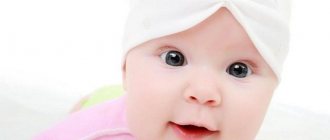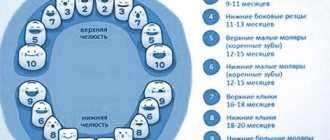Scheme for using gels during teething -
During teething, gels are applied to the gums 3-4 times a day (plus additionally before bedtime) - using a finger or a cotton swab, after which you rub the gel into the gums with gentle massaging movements. The gel will rub in better if you first dry the moist mucous membrane at the site where the gel is applied - using a dry gauze swab or sponge (otherwise the gel will slip off and be swallowed).
An important point is that the treatment of gums with gels should be carried out not before meals, but after meals and oral hygiene. In infants (especially if the treatment is carried out before the child goes to bed), it is advisable not to use gels with the anesthetic Lidocaine - to avoid swallowing problems and choking with saliva. Also, you should not use drugs that have a strong, pronounced taste (such as Cholisal gel), which will already increase the production of saliva in the child.
Also, if necessary, you can combine the use of a gel for topical use in the oral cavity with systemic drugs. These can be – 1) homeopathic medicines in dragees such as “Dantinorm Baby” or “Dentokind”, 2) a convenient form in the form of suppositories for the drug “Viburkol”. Starting from 3 months, with severe pain and/or temperature during teething, Panadol and Nurofen can also be used. Read about the effectiveness of systemic drugs at the link below.
→ Drugs for teething in children
Why does the child have a fever?
When teeth begin to cut, the child may develop a fever, which is completely normal in such a situation. What should parents do to help their baby?
- If the temperature does not exceed 38 degrees, try not to bring it down with medications; just don’t insulate or overheat the baby.
- The baby in this state is very nervous, contact with mommy is very important, so do not deny him the breast, even if it is out of your usual latching regime.
- Let your child drink water more often, because at high temperatures, dehydration occurs faster in the child’s body.
- To make the baby's teething process smoother, you need to lubricate his gums with special gels, for example Kalgel or Cholisal. After this, offer your baby a teething toy. This toy massages the gums well and distracts the baby.
- Gum massage is a very effective remedy; to do this, you need to sit the baby on your lap or simply take a position that is comfortable for both of you, and very carefully massage the gums, without pressing hard and without sudden movements.
- Try to calm the baby down, hug him, rock him, because when a baby cries, as a rule, the temperature begins to rise faster.
- If you periodically wipe the baby's body with warm water at high temperatures, paying special attention to the folds under the arms and between the legs.
Make an appointment
Anti-inflammatory toothpastes for children –
In the arsenal of oral hygiene products for young children, there are several toothpastes that have an anti-inflammatory effect and reduce gum sensitivity during teething. Their use on an ongoing basis for child oral hygiene will increase the effectiveness of the use of gels for topical use or systemic homeopathic preparations (24stoma.ru).
- Weleda children's toothpaste-gel (from 0 to 3 years)
contains the following active components - calendula extract, alginate, esculin, essential oils of mint and fennel, which have an anti-inflammatory effect. Does not contain sodium lauryl sulfate, preservatives, dyes, fluorine. Price for a 50 ml tube – from 350 rubles (made in Germany).
- SPLAT “BABY Vanilla” paste (from 0 to 3 years) is made in Russia, and the active ingredients are licorice extract, prickly pear extract, arginine, a complex of lactic enzymes (lysozyme, lactoferrin, glucose oxidase, lactoperoxidase). Most of these components have an anti-inflammatory effect and reduce the sensitivity of the gums during teething. Price per tube 40 ml from 150 rubles.
- Foam SPLAT “Junior Magic Foam” (any age) – this foam for cleansing teeth contains licorice extract, a complex of lactic enzymes, as well as creatine and dipotassium glycyrrhizinate. All these components have an anti-inflammatory effect on the oral mucosa during teething. The cost will be starting from 260 rubles (per 50 ml tube).
How to choose a teething remedy
The eruption of baby teeth is a physiological process that usually begins around 4-6 months of a child’s life and ends at about two and a half years. Regularly occurring symptoms of teething: restlessness (especially at night), increased salivation, itching, swelling and soreness of the gums. Any mother, naturally, wants to make this period of development easier for the child, relieve pain in the gums, and reduce the likelihood of sleepless nights. Therefore, mothers very often ask doctors questions: what to do when teething and how to help the child?
There are several solution options with their advantages and disadvantages:
1. Homeopathic remedies.
On the one hand, ingestion of diluted chamomile and other herbal ingredients will calm the baby, however, from the point of view of scientific medicine, they are unlikely to have any direct effect on the gums.
| 2. Systemic pain relievers (eg paracetamol, ibuprofen) They are safer, but they will also act on the baby’s body in general, and not on the gums. 3. Gels based on lidocaine or benzocaine These are local anesthetics that have an analgesic effect during teething. But there are several nuances: • Firstly, with frequent use, lidocaine and benzocaine can have a toxic effect on the body of a small child. In 2014, the US Food and Drug Administration (FDA) reported 22 cases of severe adverse events to 2% lidocaine gels in children under 3 years of age. Side effects of lidocaine included respiratory distress, decreased heart rate, decreased blood pressure, and convulsions. That is why the Department has imposed a ban on gels with high levels of it. • Secondly, age restrictions: usually from 3 or 6 months. If your baby starts teething early, these medications will not help him. In addition, such gels can have a very specific taste, and the baby may completely refuse to use it again. |
4. Gels based on natural extracts without synthetic anesthetics
These gels are based on extracts that have anti-inflammatory, analgesic and antiseptic effects.
For example, the new Italian gel for gums Dentinale® natura with herbal ingredients: aloe vera juice, boswellia and chamomile extracts, will help postpone the teething period without resorting to analgesics and anesthetics.
Dentinale® natura has a mild anti-inflammatory and antiseptic effect. The gel does not contain :
• synthetic painkillers
• sugar
• parabens
It is almost impossible to overdose on such a drug, it is harmless if swallowed, side effects are not described and theoretically can only be associated with individual intolerance to the components of the gel.
Pleasant to the taste and has no age restrictions.
Easy teething and good nights!
PRODUCTS BY THEME: Dentinale
You can read the reviews at the link: https://www.babyblog.ru/td/itog/41
A few final recommendations for parents:
Below we list some more tips for parents that will help you understand the behavior of a small child, for example, when he feels discomfort during teething.
1) The baby is constantly trying to chew something -
In this case, you can use a clean finger or special teething rings to massage the baby’s gums for 2 minutes (should be repeated several times a day). Finger massage calms most children, allowing them to relieve itching in the gums, but some children may protest against such a massage. Of course, it is best in this case to provide the child with special safe items for chewing (rubber teething rings). By the way, they can be additionally cooled, and then your baby will calm down even faster.
2) Refusal to eat –
Keep in mind that eating warm foods will aggravate teething symptoms, while eating cool, cool foods will provide relief for your baby.
3) If the skin around the mouth, chin is irritated -
You should regularly wipe the baby's skin around the mouth dry. If a rash or irritation occurs, you should treat the skin with a special baby cream that will contain various anti-inflammatory components.
4) If the baby rubs his cheek or ear -
In this case, the child is trying to say that he has some kind of pain or discomfort. And this does not mean at all that the child has ear inflammation, because... When teething, pain often radiates along nerve fibers to other areas. In this case, you should give the child a mild pain reliever, for example, Panadol and Nurofen. We hope that our article was useful to you!
Sources:
1. Dental education of the author of the article, 2. Based on personal experience as a dentist, 3. The European Academy of Pediatric Dentistry (EU), 4. National Library of Medicine (USA), 5. https://www.vidal. ru/, 6. “Pediatric therapeutic dentistry. National leadership" (Leontyev V.K.).
Ways to relieve teething pain
How can you help your baby cope with teething?
Teething is a difficult time for both children and parents. Most often, children become excitable, capricious, and irritable. Additionally, there are other signs of teething such as increased drooling or drooling. There is no need to worry too much as there are several ways that can help reduce discomfort and pain.
What is teething?
When teething occurs in babies and children, the growing teeth begin to penetrate the gum tissue that hides them and come out. Some children experience more severe pain, others less. Here are some signs and symptoms that can tell you your baby is starting to teethe:
- The gums in the area where the tooth is expected to erupt become inflamed and swollen.
- Your baby's cheek on the teething side may become red and hot.
- Children may constantly rub the ear on the teething side.
- The child begins to chew everything that comes to hand.
- Salivation increases, which can result in irritation on the chin.
- The child becomes irritable and shows other signs of discomfort, such as restless sleep and refusal to eat.
- During this time, children's temperature may periodically rise slightly.
What is the average duration of teething in children?
Typically, the first tooth appears between 6 months and one year of age.
A baby is born with all 20 baby teeth already under the gum - just waiting to emerge. And there is a clear pattern or order of teething. The front teeth (incisors) usually erupt first, and all subsequent teeth, upper and lower, appear one after another. The first molars at the end of the gums begin to appear around 12–15 months of age, while the canines usually erupt by the age of one and a half years. All baby teeth usually appear by age three.
How to soothe teething pain:
There are several options for helping your baby teething to make this difficult period of his life more comfortable:
Chew toys
You can purchase special chewing rings in a wide variety of shapes and materials designed for a child during this period. These rings help to significantly reduce the child’s discomfort and help the tooth appear as quickly as possible.
You can also use chewing toys (made from special soft fabric) and various nipples for a baby bottle.
Proper nutrition
Cool water is the best option during teething, especially if your baby drinks from a special sippy cup. Drinking a chilled drink will somewhat soothe irritated and inflamed gums in the same way as drinking fruit purees or drinking yoghurt in a cool form.
Creative distraction or special game
Try to distract your child with some creative activities from discomfort and pain in the mouth. Cuddle him, play with him, prepare a warm bath for him. If your baby is still breastfed, feed him.
Gum massage
If you lightly massage your baby's gums with a clean finger, the pain will calm down a little. This may also help the tooth erupt.
Skin protection
You can use baby cream to reduce chin irritation. It is also necessary to change the child’s bedding in a timely manner.
Dental gels
Such drugs are presented by many pharmaceutical companies. They may contain local anesthetic components. Gels give temporary results because they are easily washed off with saliva.
Children's dental gels contain components with a high safety profile, some of which can be used as early as 5 months of age. It is recommended to follow the instructions for use and use only drugs that are registered for children of the appropriate age.
Fever and pain
You should see a doctor if your baby has a high fever or is unusually uncomfortable or painful, which indicates something more serious than teething symptoms.
Finally, don't forget that all children teeth naturally, so don't take your child's painful illnesses too seriously during this difficult time for him (and his family).






